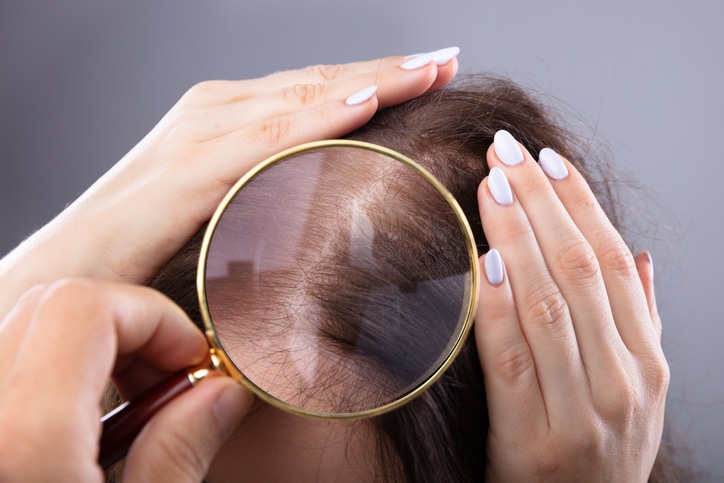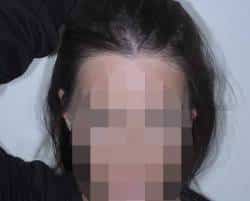Hair loss is not just a men’s issue – it’s a reality for many women, too. Watching your hair thin over time can be frustrating and impact your confidence, but you are not alone in this experience.
Female pattern alopecia, a genetic condition, causes gradual thinning, typically starting at the part line and progressing over time. Dr. Alfonso Barrera and Dr. Eric Ruff in Houston, Texas, offer hair transplantation to restore fuller hair in women. With years of experience in aesthetic and reconstructive procedures, our surgeons provide custom solutions for those experiencing hair loss.

What Is Female Pattern Alopecia?
Female pattern alopecia makes hair follicles overly sensitive to a hormone called DHT, leading to gradual thinning across the scalp. Unlike male hair loss, women typically retain their front hairline while experiencing overall thinning. Other factors like aging, hormonal changes, and menopause can also contribute to this type of hair loss.
Female Hair Transplant
Modern hair transplantation uses tiny grafts to create natural-looking results. These grafts come in two types:
- Micrografts (1–2 hair follicles per graft)
- Minigrafts (3–4 hair follicles per graft)
Dr. Barrera can transplant 1,000–2,800 grafts in a single session. Smaller grafts (1–2 hairs) are placed at the hairline for a soft, natural look, while larger grafts (3–4 hairs) are used behind them for added density.
The process involves taking a small strip of scalp from the donor area (usually the back of the head), which is then divided into individual grafts. The donor area is carefully closed with sutures to minimize scarring, and these sutures are removed in about 10 days.
“With the advances in hair transplantation over the past two decades, truly natural results – without detectable scarring – can be consistently accomplished,” states Dr. Barrera.
Candidates for Hair Transplant
Not everyone experiencing hair loss is a good candidate for a hair transplant. The best candidates for the procedure typically:
- Have female pattern alopecia with overall thinning but an intact front hairline.
- Have a healthy donor area – typically at the back of the head – where hair can be transplanted.
- Are in good overall health, as certain medical conditions may affect healing and hair growth.
- Have realistic expectations, understanding that hair transplants restore density but do not stop ongoing hair loss.
A consultation with Dr. Barrera or Dr. Ruff will help determine if a hair transplant is the right option based on your hair loss pattern and donor hair availability.
What Can I Expect After My Hair Transplant?
Hair transplantation is a gradual process, and understanding this general timeline can help you set realistic expectations:
- First 10 Days: The transplanted hair begins to grow.
- Weeks 2–4: Most of the transplanted hair falls out, which is completely normal.
- Months 3–4: Hair enters a resting phase before new growth begins.
- Months 5–6: Noticeable improvement as new hair grows in.

For the first few months, it may seem like nothing is happening – or even that thinning has worsened due to the shedding of existing hair in the grafted area. However, once the hair enters the growth phase, it continues to grow just as it would in the donor area.
This natural progression actually works to your advantage. Since the change happens slowly, those around you will simply see your hair looking fuller over time.
Micrografts and Minigrafts
The use of micrografts (1–2 hairs per graft) and minigrafts (3–4 hairs per graft) revolutionized hair transplantation in 1991 when Dr. Uebel introduced the technique in Brazil. This method allowed for natural-looking coverage of large areas, particularly in cases of male pattern baldness.
Dr. Barrera has refined and advanced this approach, using finer microblades and increasing the number of grafts per session – now reaching up to 2,800 grafts in a single procedure.
What Causes Female Pattern Alopecia?
Hair loss is normal in everyone as we age – this is true of women and men. Up to two-thirds of women experience hair loss after they exit menopause. Less than half of women will make it past age 65 with a full head of hair. If it happens when you are younger, like in your 20s or 30s, the cause usually is genetics (hereditary). However, hormonal imbalances must still be ruled out.
How Is Female Pattern Hair Loss Different Than in Men?
In men, hair loss starts in the front of the head and recedes backward until the entire area is without hair. Women tend to lose hair from all over the head, starting at the part line. Hair also recedes at the temples. Women are far less likely to go completely bald than men, but there can be extensive thinning.
Doctors break female pattern alopecia into three types:
- Type 1: A small amount of thinning has started at the part line.
- Type 2: The part line has widened, and there is increased thinning around it.
- Type 3: There is thinning throughout, and the person has a see-through area at the top of the scalp.
How Many Grafts Are Needed for a Successful Hair Transplant?
The number of grafts needed depends on the extent of hair loss and the desired level of coverage. On average, a hair transplant may require:
- 1,000–1,500 grafts for mild thinning or small areas
- 1,500–2,500 grafts for moderate hair loss
- 2,500–3,000+ grafts for extensive thinning or larger areas
Each graft contains 1–4 hair follicles, and the placement is carefully planned to create natural density. During a consultation, Dr. Barrera or Dr. Ruff will assess your hair loss pattern and determine the optimal number of grafts needed for the best results.
Read what our patients are saying!
"I am so grateful, not only for your expertise, but also for your genuine kindness and concern. Your Staff along side you, always are welcoming and provide excellent care. Thank you for fitting me into you me into you hectic schedule during this busy holiday season, and for making me look and feel younger! Wishing you a wonderful Christmas and Peter and I look forward to showing and evening together in the New Year."
Click here to read more reviews.
How Many Sessions Will I Need?
It depends on the extent of hair loss and your goals. Many patients achieve satisfactory coverage in a single session, especially if they have a healthy donor area and need up to 2,500–3,000 grafts. However, because hair loss is progressive, additional sessions may be needed in the future to maintain density or address new thinning areas.
Why Should You Choose West Houston Plastic Surgery, PA?
Dr. Alfonso Barrera and Dr. Eric Ruff deliver true expertise in hair transplantation and aesthetic surgery. Dr. Barrera is a respected leader in the field, frequently invited as a visiting professor and speaker, with numerous contributions to national medical journals and plastic surgery textbooks. Dr. Ruff trained at the University of Texas at Austin and completed a competitive Plastic Surgery residency at UTMB Galveston. He has worked at prestigious hospitals, including MD Anderson Cancer Center and Shriners Hospital for Children, and has been recognized for his research and surgical excellence.
Both doctors perform hair transplantation at Dr. Barrera’s Accredited Ambulatory Surgical Facility (AAAASF), using intravenous sedation and local anesthesia. Their commitment to innovation continues to shape the field of aesthetic and reconstructive surgery.
Female Pattern Alopecia Photo Gallery


Frequently Asked Questions
There is no way to reverse or cure female pattern alopecia. At this time, the only FDA-approved option is Minoxidil (brand name Rogaine), which may help a little.
We feel that a more predictable and definite improvement can be achieved with hair transplantation. Over the past three decades, Dr. Barrera has worked to improve the technique by using and personally transplanting individual follicular unit grafts in large numbers (1000-3000).
This type of hair loss cannot be prevented, no matter what you may have read in a beauty magazine. This is a genetic condition that changes the growth pattern of the hair follicles and actually shrinks the follicles. There is nothing that can be done to stop it.
Unfortunately, hair loss is a progressive condition. We continue to lose our hair as we age, and for that reason, it’s not uncommon to need additional grafts at a later date. The transplanted hair will continue to grow on the grafted area for as long as it was genetically programmed to grow in the donor area.
A successful hair transplant requires a healthy donor area, usually at the back of the head, where hair is naturally resistant to thinning. If this area lacks enough density, a transplant may not be possible.
In some cases, alternative options like hair restoration medications or other non-surgical treatments may help improve your hair thickness.
We perform hair transplants under local anesthesia and intravenous sedation, so patients typically feel little to no discomfort during the procedure.
Some mild soreness, tightness, or swelling in the donor and grafted areas may occur afterward, but this is temporary and manageable with prescribed or over-the-counter pain relief. Most patients find the recovery process to be tolerable and relatively easy.
Like any medical procedure, a hair transplant comes with some risks, but serious complications are rare when performed by an experienced surgeon. Potential risks include:
- Temporary swelling or bruising around the forehead or eyes
- Mild discomfort or tightness in the donor or grafted areas
- Scarring in the donor area (typically minimal if properly closed)
- Shock loss, where some existing hair temporarily sheds before regrowth
- Infection, though this is uncommon with proper aftercare
Most side effects are temporary and resolve within weeks.
Schedule a Consultation
If you’re interested in learning more about female pattern alopecia in Houston, TX, please contact us at 713-468-5200 to schedule a consultation with our practice.
